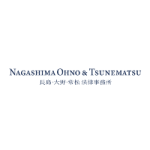This article aims to provide, at a high level, an analysis of the offshore wind market in Japan, both in terms of its potential development and its regulatory framework, to facilitate market participants considering entry into, or continued engagement with, that market. Further, the contributors set out some key considerations and issues for such market participants to think about in connection with their investments in the Japanese offshore wind market.
Contributors
1. JAPANESE GOVERNMENT TARGETS
The Japanese government’s Strategic Energy Plan sets the path for energy policy in Japan. It is formulated at least once every three years by the Ministry of Energy, Trade and Industry (“METI”). The 6th Strategic Energy Plan was approved by the Japanese Cabinet in October 2021. Its projections include targets for both 2030 and 2050.
6th Strategic Energy Plan – comparing energy mix in 2021 to projected mix by 2030
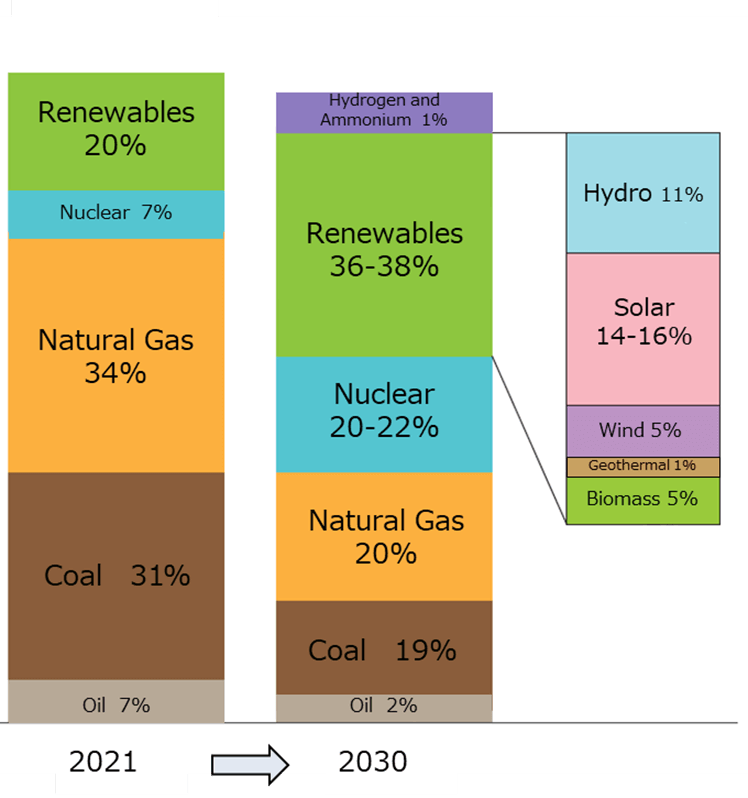
For reference, please note the renewables breakdown for 2021 was as follows: hydroelectric (7.5%); solar (8.3%); wind (0.9%); geothermal (0.3%); and biomass (3.2%).
The above sets out the targets included in the 6th Strategic Plan for Japan’s energy mix that the government intends are achieved by 2030. This projects a significant increase in the energy mix being generated from renewable energy, which means there will need to be a rapid scaling of Japanese renewables to achieve these targets. Wind power currently accounts for 0.9% of the energy mix in Japan. For wind to, as projected, meet 5% of the energy mix in Japan by 2030, there will consequently need to be a large number of new wind projects. To reinforce all of this, the government has also set a target to generate 30 – 45 GWs of offshore wind generated power by 2040.
Looking further into the future, the 6th Strategic Plan also sets a target of carbon neutrality by 2050, with the government looking to continue rapid growth in renewable energy (including solar, wind and geothermal) as well as baseload nuclear energy.¹
2. JAPANESE OFFSHORE WIND MARKET
Given this background, it is not surprising that the Japanese government, and corporate investors, are engaging with the Japanese renewables market. This interest has included recent M&A in the energy sector including ENEOS’ purchase of Japan Renewable Energy for approximately JPY200bn (US$1.4bn) and NTT Anode Energy and JERA jointly purchasing Green Power Investment for approximately JPY300bn (US$2bn). In addition, Infroneer Holdings, a Japanese infrastructure company, recently purchased Japan Wind Development from Bain Capital for JPY200bn (US$1.4bn)².
As part of this renewables expansion, the offshore wind market in Japan represents an area of key interest. This is due to, amongst other things:
(i) Potential for Growth – Japan’s offshore wind capacity currently stands at less than 0.8 GW but is planned to expand to over 5.7 GW by 2030. For future developments, Japan has over 50 GW of offshore wind capacity in the early planning stages.
(ii) Geography – Japan is an island nation and its maritime jurisdiction, including its exclusive economic zone, is 4.47m km2 (the 6th largest in the world). Due to a water depth off the Japanese coast in the majority of this seabed, Japan is particularly interested in floating offshore wind and is one of the early adopters of this technology.
(iii) Investment climate and environment – as noted above, Japanese renewables are attracting significant interest from both domestic and international investors and, as described below, there is a developed regulatory framework, coupled with a stable business climate, to facilitate the development of major offshore wind projects.³ With recently proposed legislation, this will also apply to international investors considering floating offshore wind projects in Japan’s Exclusive Economic Zone.
3. JAPANESE OFFSHORE WIND MARKET – REGULATORY FRAMEWORK
Japan is developing a regulatory framework for its growing offshore wind sector.
At a high level, the below summarises the three regulatory frameworks that govern different areas on the Japanese coastline:
- Ports/Harbours are governed by the Port and Harbour Act. After the amendment to this Act in 2019, wind farm developers can obtain occupation permits for their use of certain designated zone (within ports and harbours) for up to 30 years.
- General Sea Area (see in light yellow on the map below) is governed by the Marine Renewable Energy Act. This extends up to 12 nautical miles from the coast. This law also stipulates developers selected through public tender are permitted to use sea areas for up to 30 years.
- The Exclusive Economic Zone (see in white on the map below) is not currently governed by Japanese legislation. METI is trying to establish a new legislation for utilizing EEZ (see more below for current developments on this).
Map of Japan – showing General Sea Area and Exclusive Economic Zone⁴
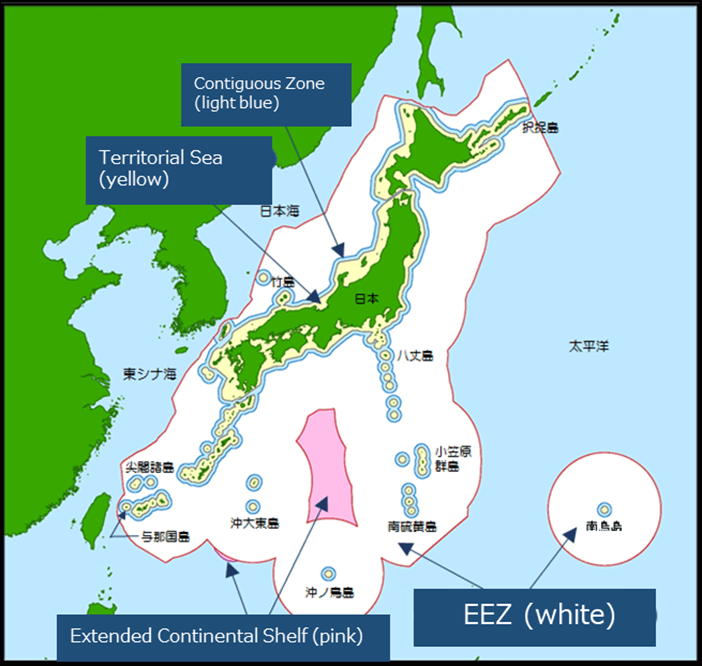
Ongoing Offshore Wind Farm Projects
| Consortium | Areas | COD | Project Cost (JPY) | |
|---|---|---|---|---|
| Marubeni | Akita Pref., Akita, Noshiro | 2022 | 100 billion | |
| GPI | Hokkaido Pref., Ishikari | 2024 | 80 billion | |
1st Round | Mitsubishi | Akita Pref., Noshiro, Mitate, Oga Akita Pref., Yurihonjo Chiba Pref., Choshi | 2028-2030 | 1.5 trillion |
2nd Round | JERA | Akita Pref., Oga Katagami, Akita | 2028 | 2 trillion |
| Mitsui | Niigata Pref., Murakami, Tainai | 2029 | ||
| Sumitomo | Nagasaki Pref.,Saikai | 2029 |
Auction process – Regulation
In the current market, the most important of these regulatory frameworks is the Marine Renewable Energy Act which came into force in 2018. It is under this legislation that the auction process for offshore wind farms off the coast of Japan is governed. To develop a project, the Japanese government will designate an area first as a “Preparatory Area” and then as a “Prospective Area”. At “Prospective Area” stage there will be a variety of investigations and consultations by government departments and a public notice to stakeholders about the designation of such zone. After this stage, the area will, if it is proceedable, become a “Promotion Area”.
The auction process for “Promotion Areas” will involve preparation of guidelines for occupancy, submission of action plans for occupancy and then selection of the most appropriate business operator. Items that are evaluated in the selection process include price, experience of the developer, proposed timing for the commencement of commercial operation, the quality of the development plan, the stability of the electricity supply and contributions to the local community.
Importantly, for the purposes of developing the power generation market in Japan, an amendment was introduced to the Act on Special Measures Concerning Procurement of Electricity from Renewable Energy Sources by Electricity Utilities in April 2022. This created a framework for a feed-in-premium system to replace a feed-in-tariff system. This restructure creates opportunities for developers that can accurately predict movement in the market and/or changes in demand as they can take advantage of such dynamic pricing. But it also introduces greater risk for developers as they may miscalculate the profitability of the project overall.
Potential Project Areas for General Sea Areas designated by the Marine Renewable Energy Act
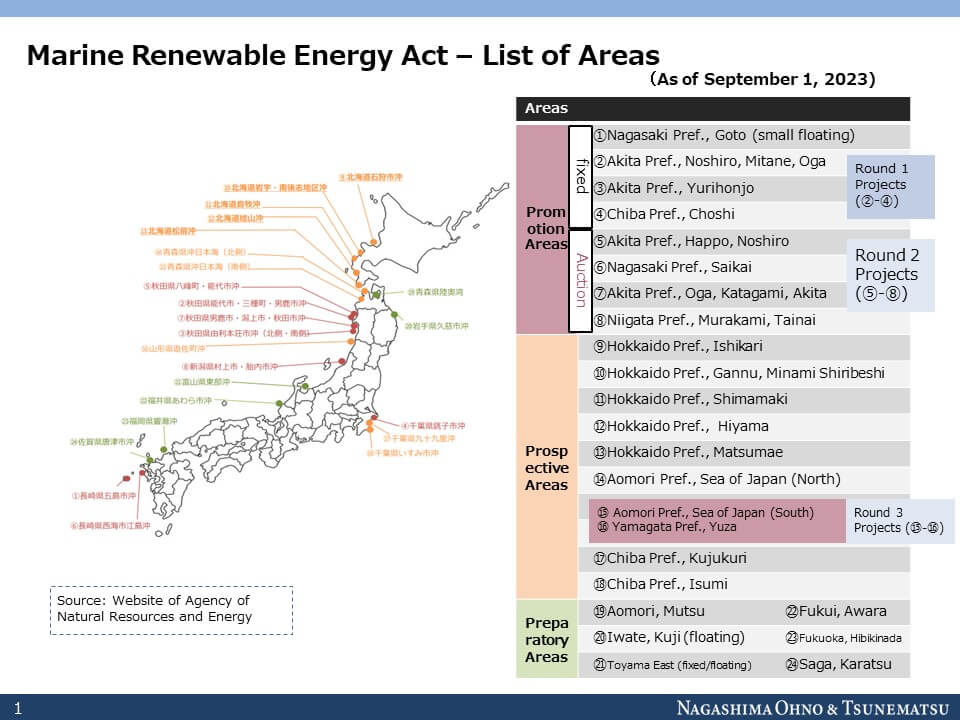
Foreign investment – Regulation
We also note the Foreign Exchange and Foreign Trade Law as relevant to developers engaging with the Japanese offshore wind market. This regulation imposes certain restrictions on foreign direct investments in key sectors in the Japanese economy, which includes the electricity generation business. The key point here is that foreign developers will need to notify the competent authority in Japan and receive confirmation prior to any investment. In practice, we note that this permission is often granted relatively easily and without issue.
4. TIMELINE
Offshore wind rounds
Japan has held two offshore wind tenders to date.
The first tender round for offshore wind projects concluded in 2021, with the same consortium led by Mitsubishi Corporation and Chubu Electric Power being awarded the occupancy permits for each of the three fixed-bottom projects Noshiro-Mitane-Oga (478 MW), Yurihonjo (819 MW), and Choshi (390 MW).⁵
The winning price for these fixed-bottom projects was far lower than the upper price limit set in each auction. This resulted in the market questioning whether the consortium could cover their costs for the projects. Such speculation, and the fact that the same consortium won all three bids, resulted in the government updating the auction rules in October 2022 to facilitate certain key changes, including that:
- speed of execution of a project was given more weight;
- if any of the bidders’ proposed price was less than the price at a zero premium, an equal score for pricing will be given to all bids below the zero premium; and
- the government could limit the grid capacity that a single bidder was able to win at once.
In the second tender round for offshore wind projects the auctions were conducted based on the feed-in-premium regime and pursuant to the revised auction rules. Of the four auctioned projects, results for three of the projects were released on 13 December 2023 with Oga-Katagami-Akita (336 MW) being awarded to a consortium of JERA, J-Power, Itochu and Tohoku Electric with a commercial operations date of 30 June 2028, Murakami-Tainai (700 MW) being awarded to a consortium of Mitsui, RWE and Osaka Gas with a commercial operation date of 30 June 2029 and Saikai-Enoshima (424 MW) being awarded to Sumitomo and TEPCO Renewable Power with a commercial operation date of 31 August 2029.
These auction results demonstrate the Japanese government’s success in diversifying the consortia of developers that are awarded offshore wind projects in its waters and procuring European investment.⁶
The third tender round is anticipated to require bid submissions by the end of July 2024 for two areas Sea of Japan (600 MW) and Yuza (450 MW).⁷
Developing offshore wind in the EEZ
A government panel recommended in 2023 that legislation be enacted to allow development of offshore wind in Japan’s EEZ. So this is a space to watch moving forward. This will involve a revision to the Marine Renewable Energy Act and the government of Japan is planning to enact the revision before the end of 2024.
This is anticipated to include allowing bidders to hold exclusive rights to an area for an offshore wind project in the EEZ for up to 30 years.
The development of wind farms in the EEZ is anticipated to follow a “two-stage formula”:
- the government will first design a “zone for taking applications” and issue a provisional permit; and
- prospective developers will form a council with local parties (including fishermen and academic experts) and, if an agreement is reached for the applicable zone, the developer will be provided with a formal permit.
Floating Offshore Wind Demonstration Projects
Connected to the viability of the EEZ for offshore wind projects in Japan will be the ability to develop, and scale, floating offshore wind in a cost-effective way; given that all projects in the EEZ will need to be floating.
To facilitate progress on its floating sector:
(i) the government of Japan is preparing a new roadmap for floating offshore wind power to be published by the end of this month (i.e. March 2024); and
(ii) the government of Japan has started accepting applications for companies to run projects for floating wind turbine demonstration projects in February 2024. The four candidate areas include: two in the northernmost prefecture of Hokkaido, one in the Akita prefecture and one in the Aichi preference. These demonstration projects range from 8 – 30km from the shore, with wind depths between 70 – 400m and projected capacities of between 10 – 90MW. Successful candidates will be chosen around May.
5. KEY ISSUES AND CONSIDERATIONS FOR OFFSHORE WIND INVESTMENT IN JAPAN
We set out below certain key issues for investors to consider in entering the Japanese offshore wind market:
- Japanese partnership – under the Marine Renewable Energy Act, a foreign investor may be a sole shareholder of a BidCo. However, given the auction guidelines provide that assessment criteria include “ability to coordinate with local administrative authorities”, “coordination and coexistence with surrounding shipping routes, fisheries, etc.” and “ripple effects on the local economy” it is practically necessary to partner with a Japanese partner to be successful. This is because having a Japanese partner ensures the appropriate strong relationship with local municipalities and residents can be appropriately managed. This certainly reflects the standard approach that consortia are taking.
- Changes of control – per the auction’s guidelines released for the first, second and third rounds, share transfers in the Bidco are possible, but the relevant authority retains the right to approve all changes to the project plan (kobo-senyo-keikaku), which includes changes of control in the Bidco. The guidelines state that the relevant authority will certify a change in parties if the share transfer (i) has a low impact on the certainty of the project’s implementation and (ii) does not significantly change the composition of the consortium members.
The guidelines clarify that the relevant authority’s judgment will require particularly careful consideration if the share transfer results: (A) before commercial operations date, in the shares of the consortium members falling below 2/3 of the total shares in the Bidco and (B) after commercial operations date, in the shares of consortium members falling below 1/2 of the total shares in the Bidco. - Local stakeholders – an investor will need to have a good level of in-person support in Japan to interact with local stakeholders to progress any offshore wind project, not least in connection with the active fishing industry.
- Local content – 40 of the 240 points in the Japanese official bidding rules are apportioned for local contribution. On a relative scale compared to other jurisdictions, this is a low proportion. But investors still need to consider the existence of the expertise, know-how and functionality to scaling wind farms at pace in Japan.
- Availability of Long term PPAs – a key consideration for any offshore wind project in Japan is its ability to find suitable offtaker(s) willing to commit over the long term. This is compounded when considering the amount of power generated by offshore wind projects, which will usually require the developer to arrange PPAs with several offtakers. Balancing the competing interests of each offtaker is likely to represent a challenging aspect of achieving a bankable PPA structure in the Japanese offshore wind market. Also note the importance of this construct in the context of the feed-in-premium system.
- Competition with other jurisdictions – in a world in which many jurisdictions are opening up their waters for offshore wind development, offshore wind investors have to consider the relative merits of different markets and opportunities. Accordingly, such investors will weigh up the issues/considerations listed above (together with others) to consider whether the Japanese offshore wind market represents the opportunity they are looking for in their portfolio of offshore wind assets.
- Consenting timelines – consenting can be one of the most time-consuming stages of offshore wind development, taking three to five years on average, and there may be challenges and delays in consenting early large projects in Japan whilst mitigating for potential environmental and social impacts.
- Technical challenges to offshore wind development in Japan – installations in Japan to date have been of smaller, pre-commercial scale. Japan poses some technical challenges moving to large commercial projects. These challenges include the occurrence of earthquakes and typhoons, and potential grid integration issues.
- Supply chain development – whilst Japan has an extensive pipeline of offshore wind projects, the national supply chain is relatively inexperienced compared to mature markets, and there is no domestic wind turbine manufacturer. It is expected that Japan will work to increase local capabilities to capture the economic benefits available from offshore wind development.
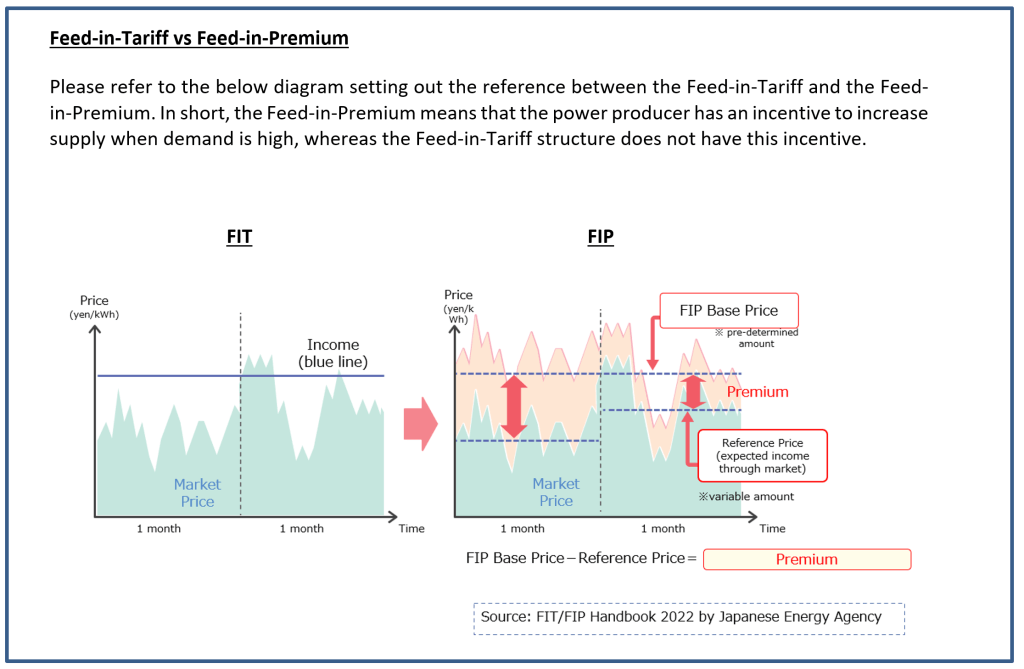
This article was published by Watson Farley & Williams LLP with contributions from Kiyoshi Honda and Kawai Saori (Nagashima Ohno & Tsunematsu) and Ivan Savitsky and Megan Smith (The Carbon Trust).
[1] We note that the government of Japan will start discussions to formulate the 7th Strategic Energy Plan this Spring.
[2] https://www.infroneer.com/en/news-article/2024/01/31/795.html
[3] Please refer to The Carbon Trust’s report “Recommendations to support skills development for Offshore Wind in Japan” for more detail on the background to the Japanese Offshore Wind Market: https://ctprodstorageaccountp.blob.core.windows.net/prod-drupal-files/documents/resource/public/Skills-and-training-need_final_March_2023.pdf
[4] Source: Website of Japan Coast Guard https://www1.kaiho.mlit.go.jp/ryokai/ryokai_setsuzoku.html
[5] The only floating offshore wind project, Goto (16.8 MW), was won by a consortium of six led by Toda Corporation.
[6] The award of the remaining round 2 auction, the Happo-Noshiro project, is scheduled to be announced this month according to METI: https://www.reuters.com/business/energy/japan-selects-three-groups-2nd-round-offshore-wind-power-tender-2023-12-13/
[7] https://www.reuters.com/business/energy/japan-launches-auction-two-offshore-wind-power-projects-2024-01-22/
